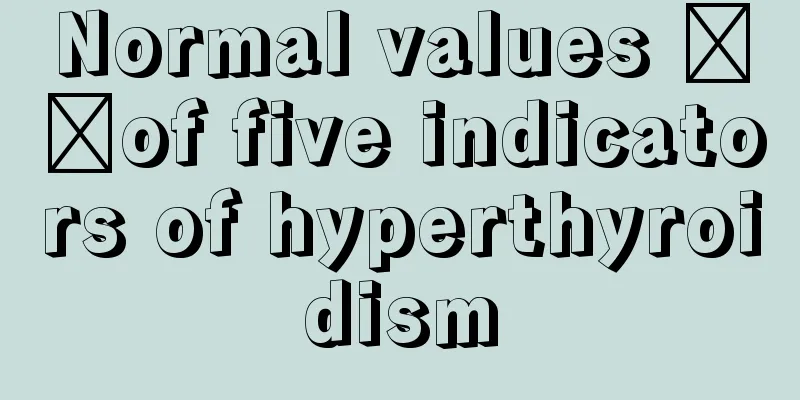Normal values of five indicators of hyperthyroidism

|
If a person's mood suddenly becomes very irritable, we can suggest that he go to the endocrinology department of the hospital to undergo five thyroid tests. This test can determine whether the person has hyperthyroidism, which can cause our emotions to become unstable. However, some people with normal five indicators of hyperthyroidism still have the risk of the disease. There are individual differences and it cannot be generalized. So, what are the normal values of the five indicators of hyperthyroidism? 1. Free T3 and free T4: They are not affected by thyroid hormone binding protein and directly reflect the state of thyroid function. Their sensitivity and specificity are significantly higher than total T3 and total T4 because only free hormone concentration can accurately reflect thyroid function, especially in cases where TBG concentration changes significantly during pregnancy, estrogen therapy, familial TGB increase or deficiency, etc. This is even more important. It is believed that the combined determination of FT3, FT4 and high-sensitivity TSH is the preferred option and first-line indicator for thyroid function assessment. Elevated levels of both are seen in hyperthyroidism; decreased levels are seen in hypothyroidism, hypopituitarism, and severe systemic diseases. 2. Serum total thyroxine TT4: It is the most basic screening test for determining thyroid function. TT4 includes the total amount of protein-bound substances, which is affected by changes in the amount and binding force of TBG and other binding proteins. Elevated TBG is common in high estrogen states, such as pregnant women or patients treated with estrogen, and women taking oral contraceptives. Patients with congenitally high TBG and familial abnormal hyperthyroxinemia have elevated TT4. Patients with hypothyroidism (such as cirrhosis and kidney disease) who take diazepam, testosterone and other drugs and congenitally low TBG have reduced TT4. At this time, physiologically active FT4 and FT3 should be measured to effectively evaluate thyroid function. 3. Serum total triiodothyronine TT3: The amount of T3 in serum that is bound to proteins is more than 99.5%, so TT3 is also affected by the amount of TBG, and the change in TT3 concentration is often parallel to that of TT4. Increased serum TT3 and TT4 concentrations are mainly seen in hyperthyroidism. Together with FT3 and FT4, they can be used in the diagnosis, disease assessment, and efficacy monitoring of hyperthyroidism and hypothyroidism. However, in the early stage of hyperthyroidism and early relapse, TT3 generally rises very quickly, about 4 times the normal level; TT4 rises slowly, only 2.5 times the normal level. Therefore, TT3 is a sensitive indicator for early efficacy observation of Hashimoto's disease and relapse after drug withdrawal. Increased TT3 and TT4 can also be seen in active hepatitis and pregnancy. Decreased T3 and T4 can be seen in hypothyroidism. In hypothyroidism, TT4 or FT4 decreases earlier than TT3 or FT3. Decreased serum total T3 or FT3 is only seen in the late stage of the disease or in severe cases. In addition, decreased serum total T3 or FT3 can be seen in hypopituitarism, malnutrition, nephrotic syndrome, renal failure, severe systemic diseases, etc. 4. TSH measurement TSH is secreted by the anterior pituitary gland and is composed of α and β subunits. Its physiological function is to stimulate the development of the thyroid gland, synthesize and secrete thyroid hormones. The secretion of TSH is affected by the excitatory effect of hypothalamic thyroid stimulating hormone, the inhibitory effect of somatostatin and the negative feedback regulation of peripheral thyroid hormone levels. A 15%-20% change in thyroid hormone levels can cause a 50%-100% change in TSH levels. TSH is not affected by TBG concentrations and is less affected by non-thyroid diseases that can affect T3 and T4. When thyroid function changes, TSH changes more rapidly and significantly than T3 and T4, so TSH in the blood is a sensitive test that reflects the function of the hypothalamus-pituitary-thyroid axis, especially for the diagnosis of subclinical hyperthyroidism and subclinical hypothyroidism. Increased TSH may be seen in primary hypothyroidism , thyroid hormone resistance syndrome, ectopic TSH syndrome, TSH-secreting tumors, and when using dopamine antagonists and iodine-containing drugs. Decreased TSH may be seen in hyperthyroidism, subclinical hyperthyroidism, PRL tumor, CUSHING disease, acromegaly, and excessive use of glucocorticoids and antithyroid drugs. The earliest manifestation of primary hypothyroidism is elevated TSH. If TSH is elevated while T3 and T4 are normal, it may be subclinical hypothyroidism. Testing TSH in umbilical cord blood, neonatal blood or amniotic fluid at the 22nd week of pregnancy can help diagnose fetal or neonatal hypothyroidism. |
<<: What does hyperthyroidism hand tremor look like
>>: Physical reactions to improvement in hyperthyroidism
Recommend
Is honey useful for removing eye bags?
Modern young people are under a lot of pressure i...
How to make fried yogurt at home
Fried yogurt can be seen in some snack streets. T...
What should I do if I find bladder cancer and prostate cancer at the same time?
Most cancer patients have tumors in a single orga...
Is it okay to apply milk on the face
Milk has many benefits and high nutritional value...
What is the function of human gallbladder
Everyone knows that there are many organs in the ...
Can you eat bananas when you are hungry and what to pay attention to
Banana is a very delicious fruit. Many of us may ...
Cow testicle cleaning steps
Some people like to eat bull testicles. Bull test...
The typical symptoms of obsessive-compulsive disorder come from checking it out
Many times we force ourselves to do something, an...
Can mid- to late-stage nasopharyngeal carcinoma be cured?
Can nasopharyngeal carcinoma in the middle and la...
How do the elderly choose mattresses
People spend at least one-third of their lives in...
7 things to note when wearing contact lenses
1. Strictly follow the correct use of contact len...
What to do with gingivitis
Gingivitis is a very painful disease. Gingivitis ...
How long after steaming can I take a shower
You can take a shower 30 minutes after sweat stea...
How to eat ginseng paste
Everyone knows that ginseng has a very good tonic...
What to eat to lose weight instead of gaining weight
For obese people, they must pay attention to thei...









